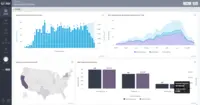Overview
What is Looker?
Looker is a BI application with an analytics-oriented application server that sits on top of relational data stores. It includes an end-user interface for exploring data, a reusable development paradigm for data discovery, and an API for supporting data in…
Recent Reviews
Awards
Products that are considered exceptional by their customers based on a variety of criteria win TrustRadius awards. Learn more about the types of TrustRadius awards to make the best purchase decision. More about TrustRadius Awards
Popular Features
- Customizable dashboards (93)8.787%
- Report sharing and collaboration (95)8.686%
- Drill-down analysis (92)8.282%
- Formatting capabilities (93)7.474%
Reviewer Pros & Cons
Pricing
Entry-level set up fee?
- Setup fee required
For the latest information on pricing, visithttps://cloud.google.com/resources/look…
Offerings
- Free Trial
- Free/Freemium Version
- Premium Consulting/Integration Services
Would you like us to let the vendor know that you want pricing?
100 people also want pricing
Alternatives Pricing
Product Demos
How To Use Looker as a Business User
YouTube
Features
Return to navigation
Product Details
- About
- Competitors
- Tech Details
- FAQs
What is Looker?
Looker, Google Cloud’s business intelligence platform, enables users to chat with data. Organizations are given self-service and governed BI to build custom applications with trusted metrics, or to bring Looker modeling to their existing environment.
Looker Studio is a part of Google's Looker Suite for business intelligence. Looker Studio is a self-serve BI solution where less technical users can create charts and reports, while Looker is a complete, enterprise BI platform, where technical users can build complex models that consider every aspect of the business. Looker Studio offers both free and pro versions, while Looker is not available for free. Looker and Looker Studio integrate with each other to support both types of analysis at businesses.
Looker vs. Looker Studio
Looker Studio is a part of Google's Looker Suite for business intelligence. Looker Studio is a self-serve BI solution where less technical users can create charts and reports, while Looker is a complete, enterprise BI platform, where technical users can build complex models that consider every aspect of the business. Looker Studio offers both free and pro versions, while Looker is not available for free. Looker and Looker Studio integrate with each other to support both types of analysis at businesses.
Looker Features
BI Platform Features
- Supported: Administration via Web Interface
- Supported: Live Connection to External Data
- Supported: In-memory data model
- Supported: Multi-Data Source Reporting (Blending)
- Supported: Data warehouse / dictionary layer
Supported Data Sources Features
- Supported: Oracle
- Supported: MS SQL Server
- Supported: IBM DB2
- Supported: Postgres
- Supported: MySQL
- Supported: Cloudera Hadoop
- Supported: Hortonworks Hadoop
- Supported: EMC Greenplum
- Supported: IBM Netezza
- Supported: HP Vertica
- Supported: ParAccel
- Supported: SAP Hana
- Supported: Teradata
- Supported: Sage 500
- Supported: SAP
BI Standard Reporting Features
- Supported: Pixel Perfect reports
- Supported: Customizable dashboards
- Supported: Report Formatting Templates
Ad-hoc Reporting Features
- Supported: Drill-down analysis
- Supported: Formatting capabilities
- Supported: Integration with R or other statistical packages
- Supported: Report sharing and collaboration
Report Output and Scheduling Features
- Supported: Publish to Web
- Supported: Publish to PDF
- Supported: Output Raw Supporting Data
- Supported: Report Versioning
- Supported: Report Delivery Scheduling
Data Discovery and Visualization Features
- Supported: Pre-built visualization formats (heatmaps, scatter plots etc.)
- Supported: Location Analytics / Geographic Visualization
- Supported: Support for Machine Learning models
- Supported: Integration with R or other statistical packages
Access Control and Security Features
- Supported: Multi-User Support (named login)
- Supported: Role-Based Security Model
- Supported: Multiple Access Permission Levels (Create, Read, Delete)
- Supported: Report-Level Access Control
- Supported: Table-Level Access Control (BI-layer)
- Supported: Field-Level Access Control (BI-layer)
Mobile Capabilities Features
- Supported: Responsive Design for Web Access
- Supported: Dashboard / Report / Visualization Interactivity on Mobile
Looker Screenshots
Looker Video
The future of Looker is powered by generative AI—Google's vision for what's next in business intelligence
Looker Competitors
Looker Technical Details
| Deployment Types | On-premise, Software as a Service (SaaS), Cloud, or Web-Based |
|---|---|
| Operating Systems | Windows, Linux, Mac |
| Mobile Application | No |
| Supported Countries | United States, Canada, United Kingdom, Mexico, Germany, France, Australia, New Zealand, South Africa, Brazil |
| Supported Languages | English |
Frequently Asked Questions
Looker is a BI application with an analytics-oriented application server that sits on top of relational data stores. It includes an end-user interface for exploring data, a reusable development paradigm for data discovery, and an API for supporting data in other systems.
Reviewers rate Report Delivery Scheduling and Multi-User Support (named login) highest, with a score of 8.9.
The most common users of Looker are from Mid-sized Companies (51-1,000 employees).





